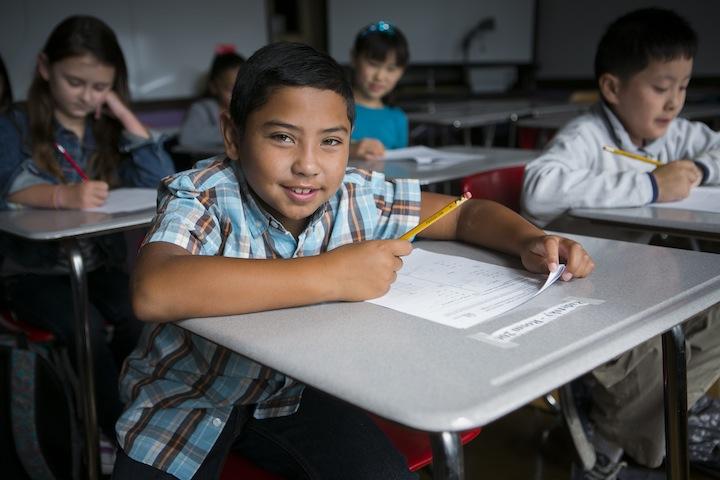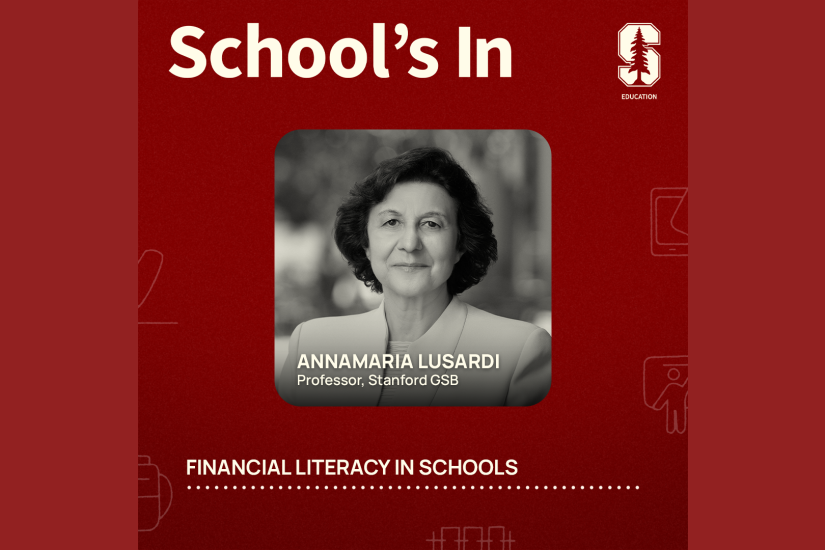
Two-language instruction best for English-language learners, Stanford research suggests
Like a growing number of school systems across the country, San Francisco Unified School District is tasked with educating increasing rolls of students for whom English is not their first language. In the United States, the school-aged population has grown a modest 10 percent in the last three decades, while the number of children speaking a language other than English at home has soared by 140 percent.
Against this backdrop, researchers at the Stanford Graduate School of Education and San Francisco Unified School District are examining student performance in various types of English language learning programs.
The preliminary findings have been the subject of a series of public presentations and have yielded two papers that are undergoing review. The studies were conducted in collaboration among SFUSD, Stanford and the Strategic Education Research Partnership (SERP).
The first paper focuses on how long it takes non-English-speaking students to reach English proficiency and be reclassified out of English Learner status. The second looks at the same students’ academic trajectories over time, comparing outcomes of four English Learner instructional program types (see sidebar). Both studies examine differential program effects by ethnicity.
The results show that while students in English immersion programs perform better in the short term, over the long term students in classrooms taught in two languages not only catch up to their English immersion counterparts, they eventually surpass them both academically and linguistically.
The researchers will present findings at a meeting of the SFUSD School Board on Tuesday, March 25. The meeting starts at 6 pm.
In their study, the researchers identified a group of about 18,000 English Learner students in the San Francisco school system who entered kindergarten as early as the fall of 2001. They were enrolled in four distinct linguistic instructional environments, and the researchers followed their progress for 10 years.
Much debate in the educational community centers on which type of educational approach works best to help non-English-speaking students learn English, as well as other subjects such as math, science and history, at the same time. Until recently, the discussion has been fueled largely by preconceptions and evidence from a set of relatively small-scale studies, because robust data on large numbers of English Learner students in diverse instructional programs was not yet available. The Stanford-SFUSD research team is among the first to do a large-scale quantitative analysis on the comparative efficacy of these programs.
“With this study we’re interested in helping the district figure out what works best for those who matter most — the students,” said Sean Reardon, professor of education and scholar at Stanford's Center for Education Policy Analysis who directed the study. “Unfortunately, in the past there has been precious little data and rigorous evidence; we wanted to see if we could provide better evidence to inform the scholarly debate.”
Adding data to the debate
Among the more significant findings, Reardon and his colleagues discovered that students in English immersion classrooms perform better than those in two-language classrooms in the early grades, but those in the two-language programs catch up or even surpass their counterparts by middle school.
Although the study found that students in English immersion programs have a better academic performance by second grade than students in programs that teach in both English and another language, this pattern changes a few years later. By middle school, the students in the two-language programs score substantially above students in the English-only programs on a range of metrics.
Take, for example, students’ performance on the state’s English Language Arts test. Although English Learners in the “Dual immersion” program score 0.15 standard deviations below their peers in English immersion in this subject in second grade, the rate of growth of their test scores is so fast that by fifth grade onward their scores surpass those of their peers in English immersion. By eighth grade they score about 0.2 standard deviations above their peers in English immersion.
“I think the big finding is that, by and large, students — particularly Latino students — who start out in the two-language programs have very different later trajectories than those starting in English Immersion,” Reardon said. “A lot of people worry that students in bilingual and dual immersion programs might never catch up, but this study shows convincingly that they do catch up and, in many ways, outperform their peers over time.”
The researchers gathered data on the diverse population of English Learner students in SFUSD. They then weighed such factors as what program the students were in, their initial level of English proficiency, and what their parents’ preferences were for the type of program their children would attend. They then examined how that cohort performed academically over the next decade.
Gathering valuable data for this type of inquiry has been a challenge in the educational policy community. The research effort needed to build a solid understanding of such questions can be considerable, and even then, many factors confound the data analysis. Grant writing for this particular study began more than four years ago, Reardon said, and the data gathering effort started — in collaboration with the San Francisco Unified School District — in earnest more than three years ago.
Tying schools to scholars
The study is part of an unusual partnership between the GSE and the San Francisco school district. The two organizations are working hand-in-hand to select research questions that are both of pressing importance to the district and that are relevant to educators nationwide.
The initiative offers Stanford researchers unprecedented access to SFUSD data, while encouraging close collaboration between researchers and practitioners, who have direct experience in what is happening in the classroom.
The English Learner research is one of several dozen research projects under way, including a study of the benefits of an iPad mathematics game and efforts to identify students at highest risk of failing to complete high school.
Christina Mei-Yue Wong, special assistant to SFUSD Superintendent Richard Carranza, and Ritu Khanna, assistant superintendent, worked closely with Reardon and his team of researchers to structure and conduct the study.
Wong noted that since 1974, the district has provided bilingual education programs to support English Learners’ access to the core curriculum. While California voters placed severe restrictions on bilingual education in 1998 with the passing of Proposition 227, SFUSD used a system of parental waivers to allow them to continue offering two-language instruction among other options for English Learners. But it was not known how two-language approaches compared with English only approaches.
“As we grew language pathways, longitudinal achievement data became critical to affirming their academic achievement,” Wong said. “The district’s partnership with the Stanford research team helped validate the district’s investment while we were also able to build our respective capacities in pathway design and data analysis.”
SFUSD proved a perfect test bed for the study, Reardon said. It has a large number of English Learners and the wide range of instructional programs.
“San Francisco Unified is a remarkably diverse school system where there are students who speak English, Spanish and Cantonese, of course, but 68 other languages as well,” he said.
Like many things related to education today, however, the issue of bilingual classrooms is complex and easily influenced by preconceptions. Reardon cautions against looking past the data.
“One of the big arguments against bilingual education is that it may do students a disservice because they don’t learn English well and also suffer academically. Others contend that English Learners in English immersion classrooms are suffering because they spend the first couple years not knowing what’s going on,” he said. “Our data suggest that students in two-language classrooms—those where they are taught both in English and their first language—do better if we just give them enough time. Focusing on the long term is key.”
Looking ahead
The researchers hope in the future to explore another related question: Whether students who are in the two-language programs have greater fluency in a language other than English, as compared with English Learners enrolled in the English immersion program. They have not yet been able to assess this, because San Francisco, like almost all school districts, does not routinely administer comparable tests of proficiency in languages other than English.
Reardon said that he is looking forward to the two papers undergoing peer review. The GSE-SFUSD partnership decided to make the findings public before that process was completed, as the results are being widely discussed, and it is important to have a statement on the record of what has been accomplished to date.
The study was supported by a grant from the Institute for Education Sciences, the research arm of the U.S. Department of Education. Ilana Umansky is lead author of the study on EL’s English proficiency and reclassification outcomes. Rachel Valentino is the lead author of the study on EL academic trajectories. Both are doctoral candidates at the Center for Education Policy Analysis.
Andrew Myers is a freelance writer who frequently covers scientific and academic research.



